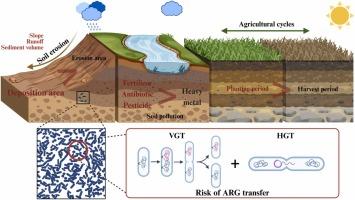Antibiotic resistance gene transfer risk: Contributions from soil erosion and sedimentation activities, agricultural cycles, and soil chemical contamination
IF 12.2
1区 环境科学与生态学
Q1 ENGINEERING, ENVIRONMENTAL
引用次数: 0
Abstract
The transfer of antibiotic resistance genes (ARGs) pose environmental risks that are influenced by soil activity and pollution. Soil erosion and sedimentation accelerate degradation and migration, thereby affecting soil distribution and contamination. This study quantified the vertical and horizontal transfer capabilities of ARGs and simulated soil environments under various scenarios, such as erosion, agricultural cycles, and chemical pollution. The results showed that slope, runoff, and sediment volume significantly affected soil erosion and ARG transfer risks. The response of environmental factors to the transfer risk of ARGs is as follows: the promotion effect of soil deposition (average: 21.41%) is significantly greater than the inhibitory effect of soil erosion (average: -11.31%); the planting period (average: -64.654) is greater than the harvest period (average: -56.225); the response to soil chemical pollution is: the impact of phosphate fertilizer residues, antibiotics, and pesticide pollution is more significant. This study constructed a vertical and horizontal transfer system of ARGs in soil erosion and sedimentation environments and proposed a response analysis method for the impact of factors, such as soil erosion and sedimentation activities, agricultural cycles, and soil chemical pollution, on ARG transfer capabilities.

抗生素耐药性基因转移风险:土壤侵蚀和沉积活动、农业循环和土壤化学污染的贡献
抗生素抗性基因(ARGs)的转移会对环境造成风险,而土壤活动和污染又会对其产生影响。土壤侵蚀和沉积会加速退化和迁移,从而影响土壤分布和污染。本研究量化了 ARGs 的垂直和水平迁移能力,并模拟了侵蚀、农业循环和化学污染等各种情况下的土壤环境。结果表明,坡度、径流和沉积物量对土壤侵蚀和 ARG 转移风险有显著影响。环境因素对 ARGs 转移风险的响应如下:土壤沉积的促进作用(平均:21.41%)明显大于土壤侵蚀的抑制作用(平均:-11.31%);种植期(平均:-64.654)大于收获期(平均:-56.225);土壤化学污染的响应为:磷肥残留、抗生素和农药污染的影响更为显著。该研究构建了水土流失与沉积环境中ARGs的垂直与水平转移系统,并提出了水土流失与沉积活动、农业循环、土壤化学污染等因素对ARGs转移能力影响的响应分析方法。
本文章由计算机程序翻译,如有差异,请以英文原文为准。
求助全文
约1分钟内获得全文
求助全文
来源期刊

Journal of Hazardous Materials
工程技术-工程:环境
CiteScore
25.40
自引率
5.90%
发文量
3059
审稿时长
58 days
期刊介绍:
The Journal of Hazardous Materials serves as a global platform for promoting cutting-edge research in the field of Environmental Science and Engineering. Our publication features a wide range of articles, including full-length research papers, review articles, and perspectives, with the aim of enhancing our understanding of the dangers and risks associated with various materials concerning public health and the environment. It is important to note that the term "environmental contaminants" refers specifically to substances that pose hazardous effects through contamination, while excluding those that do not have such impacts on the environment or human health. Moreover, we emphasize the distinction between wastes and hazardous materials in order to provide further clarity on the scope of the journal. We have a keen interest in exploring specific compounds and microbial agents that have adverse effects on the environment.
 求助内容:
求助内容: 应助结果提醒方式:
应助结果提醒方式:


